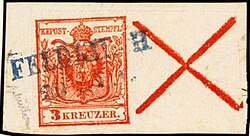St. Andrew's Cross (Philately)
In philately , the St. Andrew's Cross is a special feature that occurs in sheet-fed printing .
Andrew's cross on empty fields
The first diagonal crosses the world in stamps can be found in the first Austrian postage stamp issue from 1 June 1850. These are colored crosses, which can be found instead of the last four stamps in the bow.
At that time, a print sheet comprised four switch sheets , each with eight rows and columns. So this resulted in 64 stamps per sheet. At that time, however, it was particularly important that buying several sheets (e.g. from companies) did not result in inconvenient amounts. The currency in Austria at that time was the guilder currency, with 1 guilder equivalent to 60 kreuzers. That's why the idea came up to leave the last four fields of an arch free. When buying seven 6-kreuzer bows, for example, you only had to pay 42 guilders and not 44 guilders and 48 kreuzer.
Leaving the last four fields blank, however, resulted in a new problem that was solved with the introduction of St. Andrew's crosses. The empty fields could have been ideally used by counterfeiters to produce forged postage stamps. Therefore, it was decided to make them unusable by printing St. Andrew's crosses. The St. Andrew's crosses have the respective color of the stamp and come in two different types. The St. Andrew's cross can either be colored and the background white or vice versa. They are always in the last line of the sheet and can be placed either in the middle or on the left or right edge. Andrew's crosses were also used in the 1858 imperial head edition .
However, they were used again for a short time in 1916. The sheets of the express stamp issue at that time , where you can find these St. Andrew's crosses, consisted of 13 lines and 8 columns, so that 104 express stamps were contained in one sheet. In this case the middle four express stamps of the last line have been replaced by St. Andrew's crosses. The issue and manufacture of these arches with St. Andrew's crosses was not originally planned. Due to the great rejection of the triangular forerunners of this issue, the landscape format for this express stamp issue was adopted.
St. Andrew's crosses are very popular with collectors today. From the early years of the St. Andrew's cross, however, there are hardly any pieces that are still related to an original stamp, as the St. Andrew's crosses were hardly noticed at that time and were almost always torn away (still cut in the first issues). However, since many St. Andrew's crosses have been used as sealing marks for letters due to their rubber coating , there are still several individual pieces or strips of four. There are still many St. Andrew's crosses from 1916, as philately was already widespread at that time.
St. Andrew's cross as cancellation
In the area of the Deutsche Bundespost , St. Andrew's crosses (also known as cancellation crosses) were a form of cancellation . For the dispatch point for collector's stamps, the Federal Printing Office printed entire stamp sheets with day stamps from 1970 (from 1991 also with special first day stamps ). If the stamps were larger than the stamps, stamps in between, which only bore small segments of the stamp, were marked as rejects by St. Andrew's crosses, which were also printed, and should be destroyed after the sheets were separated. Occasionally, however, such pieces ended up in collectors' hands. The sheets of ten that have been published exclusively since October 1994 are no longer printed with cancellation crosses: stamps, regardless of size, can be placed here so that they do not necessarily touch multiple stamps. If necessary, they protrude into the edge of the sheet.
Other features at the sheet-fed printing: Combinations , decorative boxes
